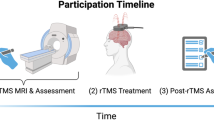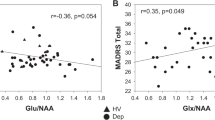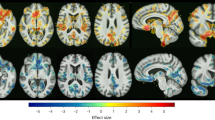Abstract
Previous proton magnetic resonance spectroscopy (1H-MRS) studies suggest a perturbation in glutamate and/or GABA in Major Depressive Disorder (MDD). However, no studies examine the ratio of glutamate and glutamine (Glx) to GABA (Glx/GABA) as it relates to depressive symptoms, which may be more sensitive than either single metabolite. Using a within-subject design, we hypothesized that reduction in depressive symptoms correlates with reduction in Glx/GABA in the anterior cingulate cortex (ACC). The present trial is a randomized clinical trial that utilized 1H-MRS to examine Glx/GABA before and after 8 weeks of escitalopram or placebo. Participants completed the 17-item Hamilton Depression Rating Scale (HDRS17) and underwent magnetic resonance spectroscopy before and after treatment. Two GABA-edited MEGA-PRESS acquisitions were interleaved with a water unsuppressed reference scan. GABA and Glx were quantified from the average difference spectrum, with preprocessing using Gannet and spectral fitting using TARQUIN. Linear mixed models were utilized to evaluate relationships between change in HDRS17 and change in Glx/GABA using a univariate linear regression model, multiple linear regression incorporating treatment type as a covariate, and Bayes Factor (BF) hypothesis testing to examine strength of evidence. No significant relationship was detected between percent change in Glx, GABA, or Glx/GABA and percent change in HDRS17, regardless of treatment type. Further, MDD severity before/after treatment did not correlate with ACC Glx/GABA. In light of variable findings in the literature and lack of association in our investigation, future directions should include evaluating glutamate and glutamine individually to shed light on the underpinnings of MDD severity. Advancing Personalized Antidepressant Treatment Using PET/MRI, ClinicalTrials.gov, NCT02623205.
This is a preview of subscription content, access via your institution
Access options
Subscribe to this journal
Receive 12 print issues and online access
$259.00 per year
only $21.58 per issue
Buy this article
- Purchase on Springer Link
- Instant access to full article PDF
Prices may be subject to local taxes which are calculated during checkout




Similar content being viewed by others
References
Brown V, Pecina M. Neuroimaging studies of antidepressant placebo effects: challenges and opportunities. Front Psychiatry. 2019;10:1–8.
Lener MS, Niciu MJ, Ballard ED, Park M, Park LT, Nugent AC et al. Glutamate and GABA systems in the pathophysiology of major depression and antidepressant response to ketamine. Biol Psychiatry. 2017;81:886–97.
Brennan B, Admon R, Perriello C, LaFlamme E, Athey A, Pizzagalli D, et al. Acute change in anterior cingulate cortex GABA, but not glutamine/glutamate, mediates antidepressant response to citalopram. Psychiatry Res Neuroimaging. 2017;269:9–16.
Sanacora G, Gueorguieva R, Epperson C, Wu Y, Appel M, Rothman D, et al. Subtype-specific alterations in gamma-aminobutyric acid and glutamate in patients with major depression. Arch Gen Psychiatry. 2004;61:705–13.
Hashimoto K. The role of glutamate on the action of antidepressants. Prog Neuropsychopharmacol Biol Psychiatry. 2011;35:1558–68.
Bhagwagar Z, Wylezinska M, Jezzard P, Evans J, Boorman E, Matthews PM, et al. Low GABA concentrations in occipital cortex and anterior cingulate cortex in medication-free, recovered depressed patients. Int J Neuropsychopharm. 2008;15:39–47.
Gabbay V, Mao X, Klein RG, Ely BA, Babb JS, Panzner AM et al. Anterior cingulate cortex γ-aminobutyric acid in depressed adolescents: relationship to anhedonia. Arch Gen Psychiatry. 2012;69:139–49.
Price RB, Shungu DC, Mao X, Nestadt P, Kelly C, Collins KA et al. Amino acid neurotransmitters assessed by 1h mrs: relationship to treatment resistance in major depressive disorder. Biol Psychiatry. 2009;65:792–800.
Abdallah C, Jackowski A, Sato JR, Mao X, Kang G, Cheema R, et al. Prefrontal cortical GABA abnormalities are associated with reduced hippocampal volume in major depressive disorder. Eur Neuropsychopharmacol. 2015;25:1082–90.
Sanacora G, Treccani G, Popoli M. Towards a glutamate hypothesis of depression: an emerging frontier of neuropsychopharmacology for mood disorders. Neuropharmacology. 2012;62:63–77.
Luykx J, Laban K, van den Heuvel M, Boks M, Mandl R, Kahn R, et al. Region and state specific glutamate downregulation in major depressive disorder: a meta-analysis of (1)H-MRS findings. Neurosci Biobehav Rev. 2012;36:198–205.
Sanacora G, Mason G, Rothman D, Behar K, Hyder F, Petroff O, et al. Reduced cortical gamma-aminobutyric acid levels in depressed patients determined by proton magnetic resonance spectroscopy. Arch Gen Psychiatry. 1999;56:1043–7.
Yildiz-Yesiloglu AA,DP. Review of 1H magnetic resonance spectroscopy findings in major depressive disorder: a meta-analysis. Psychiatry Res Neuroimaging. 2006;147:1–28.
Gunduz-Bruce H, Silber C, Kaul I, Rothschild A, Riesenberg R, Sankoh A, et al. Trial of SAGE-217 in patients with major depressive disorder. N Engl J Med. 2019;381:903–11.
Godfrey KE, Gardner AC, Kwon S, Chea W, Muthukumaraswamy SD. Differences in excitatory and inhibitory neurotransmitter levels between depressed patients and healthy controls: a systematic review and meta-analysis. J Psychiatr Res. 2018;105:33–44.
Romeo BC W, Fossati P, Rotge J. Meta-analysis of central and peripheral γ-aminobutyric acid levels in patients with unipolar and bipolar depression. J Psychiatry Neurosci. 2018;43:58–66.
Abdallah C, Jiang L, DeFeyter H, Fasula M, Krystal J, Rothman D, et al. Glutamate metabolism in major depressive disorder. Am J Psychiatry. 2014;171:1320–7.
Meltzer-Brody S, Colquhoun H, Riesenberg R, Epperson C, Deligiannidis K, Rubinow D, et al. Brexanolone injection in post-partum depression: two multicentre, double-blind, randomised, placebo-controlled, phase 3 trials. Lancet. 2018;392:1058–70.
Bhagwagar Z, Wylezinska M, Taylor M, Jezzard P, Matthews P, Cowen P. Increased brain GABA concentrations following acute administration of a selective serotonin reuptake inhibitor. Am J Psychiatry. 2004;161:368–70.
Sanacora G, Mason G, Rothman D, Krystal J. Increased occipital cortex GABA concentrations in depressed patients after therapy with selective serotonin reuptake inhibitors. Am J Psychiatry. 2002;159:663–5.
Levine J, Panchalingam K, Rapoport A, Gershon S, McClure R, Pettegrew J. Increased cerebrospinal fluid glutamine levels in depressed patients. Biol Psychiatry. 2000;47:586–93.
Yuksel C, Ongur D. Magnetic resonance spectroscopy studies of glutamate-related abnormalities in mood disorders. Biol Psychiatry. 2010;68:785–94.
Dang YH, Ma XC, Zhang JC, Ren Q, Wu J, Gao CG, et al. Targeting of NMDA receptors in the treatment of major depression. Curr Pharm Des. 2014;20:5151–9.
Kim Y, Na K. Role of glutamate receptors and glial cells in the pathophysiology of treatment-resistant depression. Prog Neuropsychopharmacol Biol Psychiatry. 2016;70:117–26.
Kugaya A, Sanacora G, Verhoeff N, Fujita M, Mason GF, Seneca NM, et al. Cerebral benzodiazepine receptors in depressed patients measured with [123i]iomazenil SPECT. Biol Psychiatry. 2003;54:792–9.
Godlewska B, Near J, Cowen P. Neurochemistry of major depression: a study using magnetic resonance spectroscopy. Psychopharmacology. 2015;232:501–7.
Walter M, Henning A, Grimm S, Schulte R, Beck J, Dydak U, et al. The relationship between aberrant neuronal activation in the pregenual anterior cingulate, altered glutamatergic metabolism, and anhedonia in major depression. Arch Gen Psychiatry. 2009;66:478–86.
Grimm S, Luborzewski A, Schubert F, Merkl A, Kronenberg G, Colla M, et al. Region-specific glutamate changes in patients with unipolar depression. J Psychiatr Res. 2009;46:1059–65.
Godlewska B, Masaki C, Sharpley A, Cowen P, Emir U. Brain glutamate in medication-free depressed patients: a proton MRS study at 7 Tesla. Psychol Med. 2018;48:1731–7.
Abdallah C, Hannestad J, Mason G, Holmes S, DellaGioia N, Sanacora G, et al. Metabotropic glutamate receptor 5 and glutamate involvement in major depressive disorder: a multimodal imaging study. Biol Psychiatry. 2017;2:449–56.
Moriguchi S, Takamiya A, Noda Y, Horita N, Wada M, Tsugawa S et al. Glutamatergic neurometabolite levels in major depressive disorder: a systematic review and meta-analysis of proton magnetic resonance spectroscopy studies. Mol Psychiatry. 2019;24:952–64.
Michael N, Erfurth A, Ohrmann P, Arolt V, Heindel W, Pfleiderer B. Metabolic changes within the left dorsolateral prefrontal cortex occurring with electroconvulsive therapy in patients with treatment resistant unipolar depression. Psychol Med. 2003;33:1277–84.
Pfleiderer B, Michael N, Erfurth A, Ohrmann P, Hohmann U, Wolgast M, et al. Effective electroconvulsive therapy reverses glutamate/glutamine deficit in the left anterior cingulum of unipolar depressed patients. Psychiatry Res. 2003;122:185–92.
Sanacora G, Mason G, Rothman D, Hyder F, Ciarcia J, Ostroff R, et al. Increased cortical GABA concentrations in depressed patients receiving ECT. Am J Psychiatry. 2003;160:577–9.
Taylor MJ, Godlewska BR, Norbury R, Selvaraj S, Near J, Cowen PJ. Early increase in marker of neuronal integrity with antidepressant treatment of major depression: 1H-magnetic resonance spectroscopy of N-acetyl-aspartate. Int J Neuropsychopharmacol. 2012;15:1541–6.
Sanacora G, Fenton L, Fasula M, Rothman D, Levin Y, Krystal J, et al. Cortical GABA concentrations in depressed patients receiving cognitive behavioral therapy. Biol Psychiatry. 2006;59:284–6.
Abdallah C, Niciu M, Fenton L, Fasula M, Jiang L, Black A, et al. Decreased occipital cortical glutamate levels in response to successful cognitive behavioral therapy and pharmacotherapy for major depressive disorder. Psychother Psychosom. 2014;83:298–307.
Legarreta MD, Sheth C, Prescot AP, Renshaw PF, McGlade EC, & Yurgelun-Todd DA. An exploratory proton MRS examination of gamma-aminobutyric acid, glutamate, and glutamine and their relationship to affective aspects of chronic pain. Neurosci Res. 2021;163:10–7.
Levar N, van Leeuwen JMC, Denys D, van Wingen GA. Divergent influences of anterior cingulate cortex GABA concentrations on the emotion circuitry. NeuroImage. 2017;158:136–44.
Horn D, Yu C, Steiner J, Buchmann J, Kaufmann J, Osoba A, et al. Glutamatergic and resting-state functional connectivity correlates of severity in major depression—the role of pregenual anterior cingulate cortex and anterior insula. Front Syst Neurosci. 2010;4:1–10.
Northoff GS E. Why are cortical GABA neurons relevant to internal focus in depression? A cross-level model linking cellular, biochemical, and neural network findings. Mol Psychiatry. 2014;19:966–77.
Hamilton M. A rating scale for depression. J Neurol Neurosurg Psychiatry. 1960;23:56–62.
First MB, Spitzer RL, Miriam G, Williams JBW. Structured clinical interview for DSM-IV-TR axis I disorders, research version, Patient Edition, (SCID-I/P). (Biometric Research Department, New York State Psychiatric Institute: New York, 2002).
Montgomery SA, Asberg M. A new depression scale designed to be sensitive to change. Br J Psychiatry. 1979;134:382–9.
Fournier JC, DeRubeis RJ, Hollon SD, Dimidjian S, Amsterdam JD, Shelton RC, et al. Antidepressant drug effects and depression severity: a patient-level meta-analysis. JAMA. 2010;303:47–53.
Landin R, DeBrota DJ, DeVries TA, Potter WZ, Demitrack MA. The impact of restrictive entry criterion during the placebo lead-in period. Biometrics. 2000;56:271–8.
Hill KR, Gardus JD, Bartlett EA, Perlman G, Parsey RV, DeLorenzo C. Measuring brain glucose metabolism in order to predict response to antidepressant or placebo: a randomized clinical trial. Neuroimage Clin. 2021;32:102858.
Lin A, Andronesi O, Bogner W, Choi IY, Coello E, Cudalbu C, et al. Minimum reporting standards for in vivo magnetic resonance spectroscopy (MRSinMRS): experts’ consensus recommendations. NMR Biomed. 2021;34:e4484.
Kreis R. The trouble with quality filtering based on relative Cramér‐Rao lower bounds. Magn Reson Med. 2016;75:15–18.
Landheer K, Juchem C. Are Cramér‐Rao lower bounds an accurate estimate for standard deviations in in vivo magnetic resonance spectroscopy? NMR Biomed. 2021;34:e4521.
Mescher M, Merkle H, Kirsch J, Garwood M, Gruetter R. Simultaneous in vivo spectral editing and water suppression. NMR Biomed. 1998;11:266–72.
Saleh MG, Edden RAE, Chang L, Ernst T. Motion correction in magnetic resonance spectroscopy. Magn Reson Med. 2020;84:2312–26.
Harris AD, Puts NA, Edden RA. Tissue correction for GABA-edited MRS: considerations of voxel composition, tissue segmentation, and tissue relaxations. J Magn Reson Imaging. 2015;42:1431–40.
Harris AD, Nicolaas AJP, Edden RAE. Tissue correction for GABA‐edited MRS: considerations of voxel composition, tissue segmentation, and tissue relaxations. J Magn Reson Imaging. 2015;42:1431–40.
Edden RA, Puts NA, Harris AD, Barker PB, Evans CJ. Gannet: a batch-processing tool for the quantitative analysis of gamma-aminobutyric acid-edited MR spectroscopy spectra. J Magn Reson Imaging. 2014;40:1445–52.
Klose U. In vivo proton spectroscopy in presence of eddy currents. Magn Reson Med. 1990;14:26–30.
Near J, Edden R, Evans CJ, Paquin R, Harris A, Jezzard P. Frequency and phase drift correction of magnetic resonance spectroscopy data by spectral registration in the time domain. Magn Reson Med. 2015;73:44–50.
Wilson M, Reynolds G, Kauppinen RA, Arvanitis TN, Peet AC. A constrained least-squares approach to the automated quantitation of in vivo (1)H magnetic resonance spectroscopy data. Magn Reson Med. 2011;65:1–12.
Keysers C, Gazzola V, Wagenmakers E. Using Bayes factor hypothesis testing in neuroscience to establish evidence of absence. Nat Neurosci. 2020;23:788–99.
Colloca L, Barsky A. Placebo and nocebo effects. N Engl J Med. 2020;382:554–61.
Whiteford HA, Harris MG, McKeon G, Baxter A, Pennell C, Barendregt JJ, et al. Estimating remission from untreated major depression: a systematic review and meta-analysis. Psychol Med. 2013;43:1569–85.
Yang J, Zhang M, Ahn H, Zhang Q, Jin T, Li I, et al. Development and evaluation of a multimodal marker of major depressive disorder. Hum Brain Mapp. 2018;39:4420–39.
Draganov M, Vives-Gilabert Y, Diego-Adelino J, Vicent-Gil M, Puigdemont D, Portella M. Glutamatergic and GABA-ergic abnormalities in First-episode depression. A 1-year follow-up 1H-MR spectroscopic study. J Affect Disord. 2020;266:572–7.
Njau S, Joshi S, Espinoza R, Leaver A, Vasavada M, Marquina A, et al. Neurochemical correlates of rapid treatment response to electroconvulsive therapy in patients with major depression. J Psychiatr Neurosci. 2017;42:6–16.
Colic L, von During F, Denzel D, Demenescu LR, Lord AR, Martens L, et al. Rostral anterior cingulate glutamine/glutamate disbalance in major depressive disorder depends on symptom severity. Biol Psychiatry Cogn Neurosci Neuroimaging. 2019;4:1049–58.
Yang J, Shen J. In vivo evidence for reduced cortical glutamate-glutamine cycling in rats treated with the antidepressant/antipanic drug phenelzine. Neuroscience. 2005;135:927–37.
Taylor MJ, Mannie Z, Norbury R, Near J, Cowen P. Elevated cortical glutamate in young people at increased familial risk of depression. Int J Neuropsychopharmacol. 2011;14:255–9.
Bobo WV, Angleró GC, Jenkins G, Hall-Flavin DK, Weinshilboum R, Biernacka JM. Validation of the 17-item Hamilton Depression Rating Scale definition of response for adults with major depressive disorder using equipercentile linking to Clinical Global Impression scale ratings: analysis of Pharmacogenomic Research Network Antidepressant Medication Pharmacogenomic Study (PGRN-AMPS) data. Hum Psychopharmacol. 2016;31:185–92.
Bespalov A, Steckler T, Skolnick P. Be positive about negatives-recommendations for the publication of negative (or null) results. Eur Neuropsychopharmacol. 2019;29:1312–20.
Acknowledgements
We would like to thank the Biostatistical Consulting Core at the Stony Brook University Renaissance School of Medicine, and the clinical team who coordinated participant screening and symptom scale rating: Greg Perlman, Juhayer Alam, Kate Bartolotta, Dr. Yashar Yousefzadeh-Fard, Michala Godstrey, Qurat-ul-ain Gulamhussein, Nichole Hoehn, Dan Holzmacher, Dr. Sridhar Kadiyala, Colleen Oliva, Nehal Vadhan, Jennifer Rubinstein, Dr. Laura Kunkel, and Dr. Lucian Manu. This study (ID # 570152) was approved by the IRB (3/20/2015–12/21/2021).
Funding
This study is funded by NIMH (National Institute of Mental Health) R01MH104512, Brain & Behavior Research Foundation, The Dana Foundation, and NYS Faculty Development Grant.
Author information
Authors and Affiliations
Contributions
CD and RVP designed the study and completed data collection. KW, XH, JW, and JY analyzed the data. GAN, KRH, and CD interpreted data and drafted the manuscript. All authors reviewed and edited the manuscript.
Corresponding author
Ethics declarations
Competing interests
GAN has no financial disclosures or conflicts of interest to declare. KRH has no financial disclosures or conflicts of interest to declare. XH has no financial disclosures or conflicts of interest to declare. KW has no financial disclosures or conflicts of interest to declare. JY has no financial disclosures or conflicts of interest to declare. JW has no financial disclosures or conflicts of interest to declare. RVP has no financial disclosures or conflicts of interest to declare. CD has no financial disclosures or conflicts of interest to declare.
Additional information
Publisher’s note Springer Nature remains neutral with regard to jurisdictional claims in published maps and institutional affiliations.
Rights and permissions
Springer Nature or its licensor holds exclusive rights to this article under a publishing agreement with the author(s) or other rightsholder(s); author self-archiving of the accepted manuscript version of this article is solely governed by the terms of such publishing agreement and applicable law.
About this article
Cite this article
Narayan, G.A., Hill, K.R., Wengler, K. et al. Does the change in glutamate to GABA ratio correlate with change in depression severity? A randomized, double-blind clinical trial. Mol Psychiatry 27, 3833–3841 (2022). https://doi.org/10.1038/s41380-022-01730-4
Received:
Revised:
Accepted:
Published:
Issue Date:
DOI: https://doi.org/10.1038/s41380-022-01730-4
This article is cited by
-
Higher striatal glutamate in male youth with internet gaming disorder
European Archives of Psychiatry and Clinical Neuroscience (2024)
-
A naturalistic study comparing the efficacy of unilateral and bilateral sequential theta burst stimulation in treating major depression – the U-B-D study protocol
BMC Psychiatry (2023)
-
Evaluation of brain structure and metabolism in currently depressed adults with a history of childhood trauma
Translational Psychiatry (2022)



